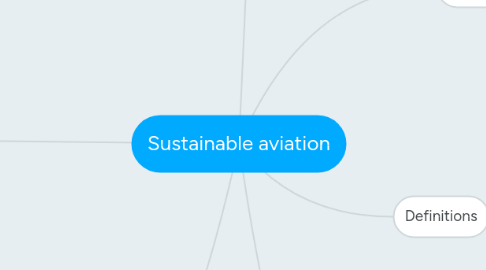
1. Industry targets
1.1. IATA
1.1.1. Improvement in fuel efficiency of 1.5% each year from 2009 to 2020
1.1.2. A cap on net av CO2 emissions from 2020
1.1.3. Reduction in net av CO2 emissions of 50% by 2050 relative to 2005 levels
2. Aims of sustainable development
2.1. Primary
2.1.1. Satisfying basic human need
2.1.2. Long term environmental protection
2.1.3. Inter generational equity
2.1.4. Intra generational equity
2.2. Secondary
2.2.1. Satisfying aspirations for improved standards of living
2.2.2. Promoting protection of environment
2.2.3. Preserving nature's intrinsic value
2.2.4. Promoting public participation
2.3. Capital
2.3.1. "anything which yields a flow of productive services over time which is subject to control in production processes"
2.3.1.1. Herfindhal and Kneese
2.3.1.1.1. 1974
2.3.2. Man made capital Human capital Natural capital
2.3.3. Each generation should leave the next generation a stock of capital no less than the stock it inherits
3. Sustainability spectrum
3.1. Very weak
3.1.1. Technocentric - cornucopian
3.1.2. Resource exploitative
3.1.3. Using technology to overcome barriers to a future that is abundant in opportunities
3.2. Weak
3.2.1. Technocentric - accommodating
3.2.2. Resource conservationist
3.2.3. Recognizes the limits nature has
3.2.4. Appreciates our effect on the environment
3.3. Strong
3.3.1. Ecocentric- communalist
3.3.2. Resource preservationist
3.3.3. Looking after society instead of the individual
3.3.4. More about how do we improve humans instead of making money
3.4. Very strong
3.4.1. Ecocentirc - deep green ecology
3.4.2. Extreme resource preservationist
3.4.3. Economy heavily regulated to minimize resource take
3.4.4. Gaia hypothesis
3.4.4.1. James Lovelock
4. Aviation growth paradox
4.1. Jevon's paradox?
4.2. The pursuing of 2 goals, where one negatively affects the other
4.2.1. As industry grows, so do the negative externalities
4.3. Every 15(ish) years there's generally a doubling in demand from 1950 to 2010 (bar 2008)
4.3.1. Drivers of growth
4.3.1.1. Population growth
4.3.1.2. Economic development
5. Definitions
5.1. Bruntland definition
5.1.1. 1987
6. Sustainable development models
6.1. Triple Bottom Line
6.1.1. John Elkington
6.1.1.1. 1997
6.1.2. Originally an accounting framework
6.1.3. Based on 3 ps
6.1.3.1. People
6.1.3.1.1. Fair and beneficial to labor and community
6.1.3.2. Planet
6.1.3.2.1. operations lead to no environmental harm/minimal impact
6.1.3.3. Profit
6.1.3.3.1. organisations create economic value
6.2. Tripartite model
6.2.1. UN World Summit Outcome Document
6.2.1.1. 2005
6.2.2. Focus on balance
6.2.2.1. All 3 pillars are equally important
6.2.3. Economic Social Environmental
6.2.3.1. E+En=B E+S=Eq En+S=V
6.2.4. Advantages
6.2.4.1. easy to understand
6.2.4.2. categorize
6.2.4.3. takes context into account
6.2.5. Disadvantages
6.2.5.1. doesn't give actual guidance for how to apply anything
6.2.5.2. no guidance for balancing and measuring

